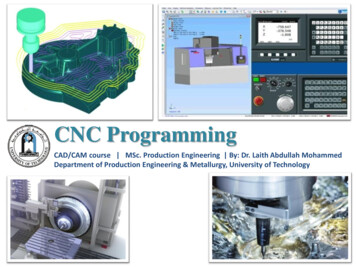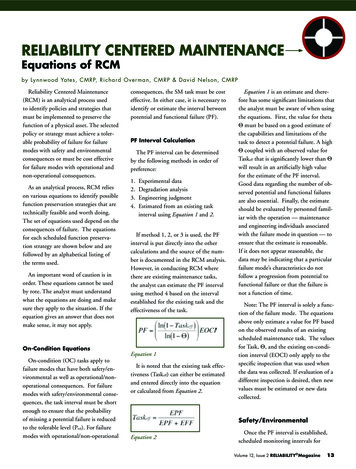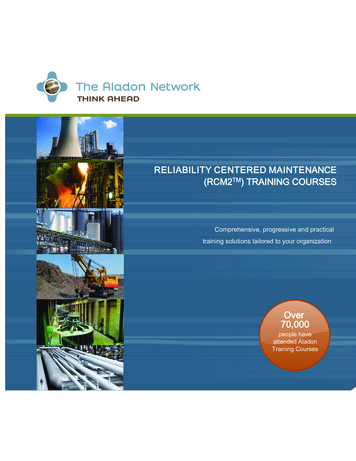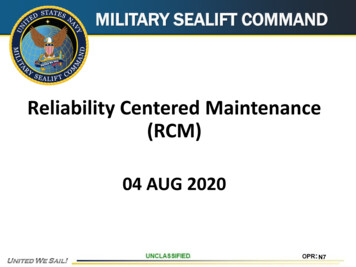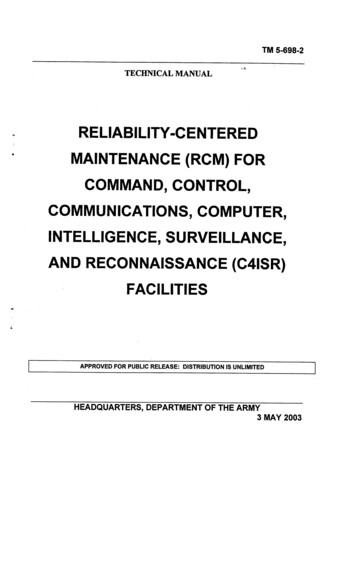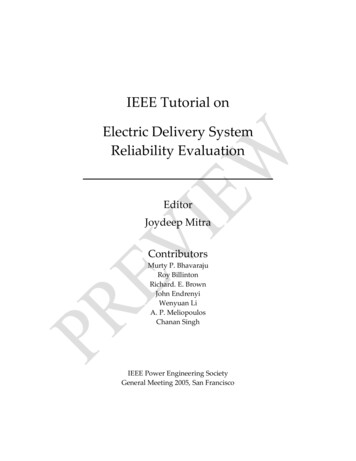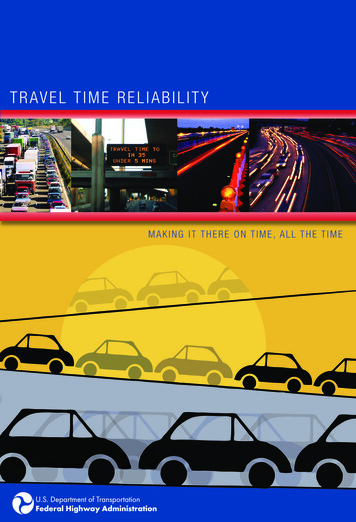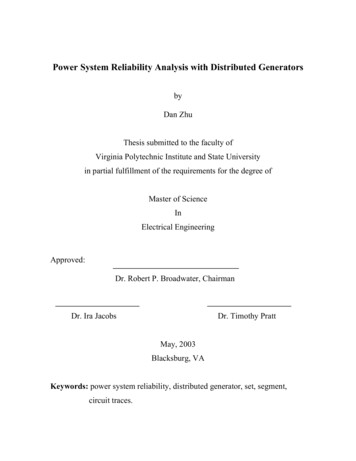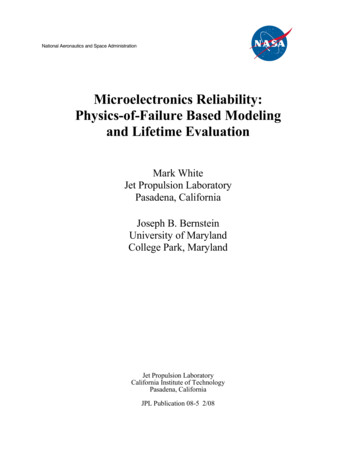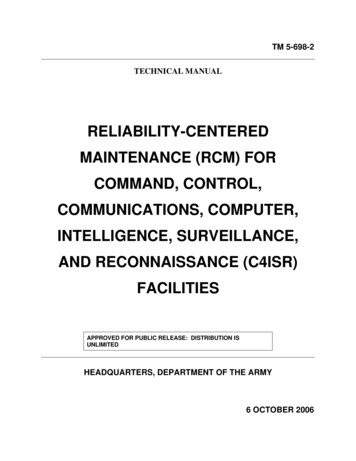
Transcription
TM 5-698-2TECHNICAL MANUALRELIABILITY-CENTEREDMAINTENANCE (RCM) FORCOMMAND, CONTROL,COMMUNICATIONS, COMPUTER,INTELLIGENCE, SURVEILLANCE,AND RECONNAISSANCE (C4ISR)FACILITIESAPPROVED FOR PUBLIC RELEASE: DISTRIBUTION ISUNLIMITEDHEADQUARTERS, DEPARTMENT OF THE ARMY6 OCTOBER 2006
TM 5-698-2REPRODUCTION AUTHORIZATION/RESTRICTIONSThis manual has been prepared by or for the Government and, except to the extent indicated below, is public property and not subject to copyright. Reprintor republication of this manual should include a credit substantially as follows:"Department of the Army, TM 5-698-2, Reliability-Centered Maintenance(RCM) for Command, Control, Communications, Computer, Intelligence, Surveillance, and Reconnaissance (C4ISR) Facilities, 6 October 2006.
TM 5-698-2Technical ManualNo. 5-698-2HEADQUARTERSDEPARTMENT OF THE ARMYWashington, DC, 6 October 2006APPROVED FOR PUBLIC RELEASE: DISTRIBUTION IS UNLIMITEDRELIABILITY-CENTERED MAINTENANCE (RCM) FOR COMMAND,CONTROL, COMMUNICATIONS, COMPUTER, INTELLIGENCE,SURVEILLANCE, AND RECONNAISSANCE (C4ISR) FACILITIESCONTENTSParagraph PageCHAPTER 1. INTRODUCTION TO RELIABILITY-CENTERED MAINTENANCEPurpose.Scope.References.Availability, maintenance, and reliability .The reliability-centered maintenance (RCM) concept .Benefits of RCM .Origins of RCM .Relationship of RCM to other disciplines.CHAPTER 2. ESSENTIAL ELEMENTS OF A SUCCESSFUL RCM PROGRAMRCM implementation plan.Data collection requirements .Data analysis .Commitment to life cycle support of the program .RCM as a part of design.Focus on the four Ws .CHAPTER 3. MAINTENANCE OF SYSTEMSIntroduction.Categories of maintenance .Categorization by when maintenance is performed .Maintenance concepts .Packaging a maintenance program.CHAPTER 4. FUNDAMENTAL CONCEPTS OF A RELIABILITY-CENTEREDMAINTENANCE PROGRAMObjectives of RCM .Applicability of preventive maintenance .Failure .Reliability modeling and analysis .CHAPTER 5. THE RELIABILITY-CENTERED MAINTENANCE PROCESSOverview.C4ISR candidates for RCM analysis.RCM data sources .PM tasks under RCM.The RCM process.Specific considerations for implementing RCM for C4ISR facilities.Evaluation of alternatives.THIS MANUAL SUPERSEDES TM 5-698-2 DATED 3 MAY 35-45-55-65-75-15-15-25-45-55-285-30i
TM 5-698-2CONTENTSParagraph PageCHAPTER 6. CONTRACTING FOR MAINTENANCEIntroduction to maintenance contracting.Approach for C4ISR facilities.Measures of performance.Scope of the contract.Monitoring performance .Incentives .APPENDIX A REFERENCESAPPENDIX B STATISTICAL DISTRIBUTION USED IN RELIABILITY ANDMAINTAINABILITYIntroduction to statistical distribution .The exponential distribution .The weibull distribution.The normal distribution .The lognormal distribution .APPENDIX C AVAILABILITY AND OPERATIONAL READINESSAvailability .Operational readiness.APPENDIX D ACRONYMS GLOSSARYAPPENDIX E FLEXIBLE RCM METHOLOGY B-3B-4B-5B-1B-1B-2B-3B-4C-1C-2C-1C-3E-1E-1LIST OF 45-55-65-75-85-95-105-115-125-135-146-1iiTitleCost benefits of using RCM for developing PM program .Data sources for the RCM analysis.Non-destructive inspection (NDI) techniques, briefly .Examples of failure mechanisms and modes .Examples of failure effect categorization .Examples of tasks under two categories of preventive maintenance .Examples of effects of operational failures.Methods for modeling reliability .Key features of the GO method .Criteria for applying RCM to products .Types of mechanical systems typical for a C4ISR facility .Typical components comprising the C4ISR facility electrical system .Typical components for a SCADA system .General data sources for the RCM analysis .Potential sources of C4ISR maintainability data .Understanding and using different sources of data .NDI techniques .Information needed for RCM.Example of identified tasks.Packaging the tasks from table 5-4 .Typical questions addressed by a reliability assessment.Steps in design trades.Typical costs considered in cost-benefit analysis .Examples of positive 25-25-35-35-45-95-115-265-265-275-305-316-4
TM 5-698-2CONTENTSLIST OF 5-25-35-45-55-65-7TitleThe RCM process starts in the design phase and continues for the life ofthe system.Applicability of age limit depending on failure pattern .Major categories of maintenance by when performed .Typical approach to categorizing maintenance by where it is performed.An example of packaging PM tasks.Example of how PM cards can be used to document required PM tasks.Block diagram of a simple redundant system .Example of a reliability block diagram.Example of a fault tree (from RAC Fault Tree Analysis ApplicationGuide) .Example of a single line diagram (from IEEE Gold BookStandard Network) .Data elements from FMEA that are applicable to RCM analysis .Example of Failure Modes and Effects Analysis worksheet; DA Form 7610RCM decision logic tree (adapted from MSG-3).Evident failure – hazardous effects .Evident failure – operational effects .Evident failure – economic effects.Hidden failure – hazardous effects.Hidden failure – non-hazardous effects .THIS MANUAL SUPERSEDES TM 5-698-2 DATED 3 MAY -145-175-195-215-235-25
TM 5-698-2CHAPTER 1INTRODUCTION TO RELIABILITY-CENTERED MAINTENANCE1-1. PurposeThe purpose of this technical manual is provide facility managers with the information and proceduresnecessary to develop and update a preventive maintenance (PM) program for their facilities that is basedon the reliability characteristics of equipment and components and cost. Such a PM program will help toachieve the highest possible level of facility availability at the minimum cost.1-2. ScopeThe information in this manual reflects the commercial practices and lessons learned over many years ofdeveloping cost-effective preventive maintenance programs for a wide variety of systems and equipment.It specifically focuses on developing PM programs for electrical and mechanical systems used incommand, control, communications, computer, intelligence, surveillance, and reconnaissance (C4ISR)facilities based on the reliability characteristics of those systems and economic considerations, whileensuring that safety is not compromised. The process for developing such a PM program is calledReliability-Centered Maintenance, or RCM. Two appendices develop key topics more deeply: appendixB, statistical distribution; and appendix C, availability.1-3. ReferencesAppendix A contains a complete list of references used in this manual.1-4. Availability, maintenance, and reliabilityIn addition to the following key terms, the glossary lists acronyms, abbreviations, and additionaldefinitions for terms used in this document. Additional terms are included to help the reader betterunderstand the concepts presented herein.a. Availability. (Also see appendix C). Availability is defined as the instantaneous probability that asystem or component will be available to perform its intended mission or function when called upon to doso at any point in time. It can be measured in one of several ways.(1) Operational availability(Ao). Another equation for availability directly uses parameters relatedto the reliability and maintainability characteristics of the item as well as the support system. Equation 1reflects this measure.Ao Mean Time Between Maintenance (MTBM)Mean Downtime MTBMEquation 1(2) Inherent availability(Ai). In equation 1, MTBM includes all maintenance required for anyreason, including repairs of actual design failures, repairs of induced failures, cases where a failure cannotbe confirmed, and preventive maintenance. When only maintenance required to correct design failuresare counted and the effects of the support system are ignored, the result is inherent availability, which isgiven by equation 2.1-1
TM 5-698-2Ai Mean Time Between Failure (MTBF)Mean Time to Repair MTBFEquation 2b. Maintenance. Maintenance is defined as those activities and actions that directly retain the properoperation of an item or restore that operation when it is interrupted by failure or some other anomaly.(Within the context of RCM, proper operation of an item means that the item can perform its intendedfunction.) These activities and actions include removal and replacement of failed items, repair of faileditems, lubrication, servicing (includes replenishment of consumables such as fuel), and calibrations.Other activities and resources are needed to support maintenance. These include spares, procedures,labor, training, transportation, facilities, and test equipment. These activities and resources are usuallyreferred to as logistics. Although some organizations may define maintenance to include logistics, it willbe used in this TM in the more limited sense and will not include logistics.(1) Corrective maintenance. Corrective maintenance is maintenance required to restore a faileditem to a specified condition. Restoration is accomplished by removing the failed item and replacing itwith a new item, or by fixing the item by removing and replacing internal components or by some otherrepair action.(2) Preventive maintenance. Scheduled maintenance or maintenance performed based on thecondition of an item conducted to ensure safety, reduce the likelihood of operational failures, and obtainas much useful life as possible from an item.(3) Condition-based maintenance. Condition-based maintenance can be performed on the basis ofobserved wear or on predicting when the risk of failure is excessive.(a) Some items exhibit wear as they are used. If the probability of failure can be related to ameasurable amount of wear, it may be possible to prescribe how much wear can be tolerated before theprobability of failure reaches some unacceptable level. If so, then this point becomes the criterion forremoval or overhaul. Measurement can be done using a variety of techniques depending on thecharacteristic being measured. The length of cracks in structures, for example, can be measured using xray and ultrasound.(b) In predictive maintenance, a given operating characteristic of the item, vibration ortemperature, for example, is trended and compared with the known "normal" operating levels. Anacceptable range is established with either upper and lower limits, or some maximum or minimum level.As long as the trend data remain inside the acceptable level, any variation is considered to be normalvariation due to variances in materials, operating environment, and so forth. When the trend lineintersects the "unacceptable" limit line, preventive maintenance is required to prevent a failure in thefuture. The limits are based on knowledge of the normal operating characteristics and the level of risk offailure we are willing to accept.c. Reliability. Reliability is defined as the probability that a component can perform its intendedfunction for a specified time interval (t) under stated conditions.d. Reliability-centered maintenance (RCM). RCM is a logical, structured framework for determiningthe optimum mix of applicable and effective maintenance activities needed to sustain the operationalreliability of systems and equipment while ensuring their safe and economical operation and support.Although RCM focuses on identifying preventive maintenance actions, corrective actions are identifiedby default. That is, when no preventive action is effective or applicable for a given item, that item is run1-2
TM 5-698-2to failure (assuming safety is not at issue). From that perspective, RCM identifies all maintenance. RCMis focused on optimizing readiness, availability, and sustainment through effective and economicalmaintenance.1-5. The reliability-centered maintenance conceptPrior to the development of the RCM methodology, it was widely believed that everything had a "right"time for some form of preventive maintenance (PM), usually replacement or overhaul. A widespreadbelief among many maintenance personnel was that by replacing parts of a product or overhauling theproduct (or reparable portions thereof), that the frequency of failures during operation could be reduced.Despite this previous commonly held view, the results seemed to tell a different story. In far too manyinstances, PM seemed to have no beneficial effects. Indeed, in many cases, PM actually made thingsworse by providing more opportunity for maintenance-induced failures.a. Airline study. When the airline companies in the United States observed that PM did not alwaysreduce the probability of failure and that some items did not seem to benefit in any way from PM, theyformed a task force with the Federal Aviation Administration (FAA) to study the subject of preventivemaintenance. The results of the study confirmed that PM was effective only for items having a certainpattern of failures. The study also concluded that PM should be required only when required to assuresafe operation. Otherwise, the decision to do or not do PM should be based on economics.b. RCM approach. The RCM approach provides a logical way of determining if PM makes sense for agiven item and, if so, selecting the appropriate type of PM. The approach is based on the followingprecepts.(1) The objective of maintenance is to preserve an item's function(s). RCM seeks to preserve systemor equipment function, not just operability for operability's sake. Redundancy improves functionalreliability but increases life cycle cost in terms of procurement and life cycle cost.(2) RCM focuses on the end system. RCM is more concerned on maintaining system function thanindividual component function.(3) Reliability is the basis for decisions. The failure characteristics of the item in question must beunderstood to determine the efficacy of preventive maintenance. RCM is not overly concerned withsimple failure rate; it seeks to know the conditional probability of failure at specific ages (the probabilitythat failure will occur in each given operating age bracket).(4) RCM is driven first by safety and then economics. Safety must always be preserved. Whensafety is not an issue, preventive maintenance must be justified on economic grounds.(5) RCM acknowledges design limitations. Maintenance cannot improve the inherent reliability – itis dictated by design. Maintenance, at best, can sustain the design level of reliability over the life of anitem.(6) RCM is a continuing process. The difference between the perceived and actual design life andfailure characteristics is addressed through age (or life) exploration.c. RCM concept. The RCM concept has completely changed the way in which PM is viewed. It isnow a widely accepted fact that not all items benefit from PM. Moreover, even when PM would beeffective, it is often less expensive (in all senses of that word) to allow an item to "run to failure" ratherthan to do PM. In the succeeding discussions, we will examine the RCM concept in more detail. We will1-3
TM 5-698-2explore the meaning of terms that are central to the RCM approach. These terms include failurecharacteristics, efficiency, run to failure, cost, and function.1-6. Benefits of RCMa. Reduced costs. A significant reason for creating the aforementioned joint airline/FAA task force wasthe new Boeing 747 (B747) jumbo jet. Boeing and United Airlines, the initial buyer of the aircraft, werealready considering the development of the PM program for the B747. This new airliner was vastly largerand more complex than any ever built. Given the cost of maintenance on smaller aircraft already inservice, the maintenance costs for the B747, using the traditional approach to PM, would have threatenedthe profitability, and hence the viability, of operating the new aircraft. Examples of the ultimate savingsachieved in using RCM to develop the PM program for the B747 and other aircraft are shown in table 1-1.Similar savings have been achieved by other industries for other equipment when going from a traditionalto an RCM-based PM program. It is important to note that these costs savings are achieved with noreduction in safety, an obvious requirement in the airline industry.Table 1-1. Cost benefits of using RCM for developing PM programType of PMStructural inspectionsOverhaulOverhaul of turbineengineRequired UsingTraditional ApproachRequired Using RCM4,000,000 hours for DC- 66,000 hours for B7478339 items for DC-87 items for DC-10ScheduledOn-condition (cut shopmaintenance costs by 50%compared with DC-8)b. Increased availability. For many systems, including C4ISR facilities, availability is of primaryimportance. Availability was defined in paragraph 1-4. As indicated in the definition, the level ofavailability achieved in actual use of a product is a function of how often it fails and how quickly it can berestored to operation. The latter, in turn, is a function of how well the product was designed to bemaintainable, the amount of PM required, and the logistics resources and infrastructure that have been putin place to support the product. RCM directly contributes to availability by reducing PM to that which isessential and economic.1-7. Origins of RCMa. Airlines. As stated earlier, RCM had its origins with the airline industry. Nowhere had the thenprevailing philosophy of maintenance been challenged more. By the late 1950's, maintenance costs in theindustry had increased to a point where they had become intolerable. Meanwhile, the Federal AviationAgency (FAA) had learned through experience that the failure rate of certain types of engines could notbe controlled by changing either the frequency or the content of scheduled fixed-interval overhauls. As aresult of these two factors, a task force consisting of representatives of the airlines and aircraftmanufacturers was formed in 1960 to study the effectiveness of PM as being implemented within theairline industry.(1) The task force. The task force developed a rudimentary technique for developing a PM program.Subsequently, a maintenance steering group (MSG) was formed to manage the development of the PMprogram for the new Boeing 747 (B747) jumbo jet. This new airliner was vastly larger and more complexthan any ever built. Given the cost of maintenance on smaller aircraft already in service, the maintenance1-4
TM 5-698-2costs for the B747, using the traditional approach to PM, would have threatened the profitability, andhence the viability, of operating the new aircraft.(2) MSG-1. The PM program developed by the steering group, documented in a report known asMSG-1, was very successful. That is, it resulted in an affordable PM program that ensured the safe andprofitable operation of the aircraft.(3) MSG-2. The FAA was so impressed with MSG-1 that they requested that the logic of the newapproach be generalized, so that it could be applied to other aircraft. So in 1970, MSG-2, AirlineManufacturer Maintenance Program Planning Document, was issued. MSG-2 defined and standardizedthe logic for developing an effective and economical maintenance program. MSG-2 was first used on theL1011, DC10, and MD80 aircraft. In 1972, the European aviation industries issued EMSG (EuropeanMaintenance System Guide), which improved on MSG-2 in the structures and zonal analysis. EMSG wasused on the Concorde and A300 Airbus.b. Adoption by military. The problems that the airlines and FAA had experienced with the traditionalapproach to maintenance were also affecting the military. Although profit was not an objective commonto both the airlines and military, controlling costs and maximizing the availability of their aircraft were.Consequently, in 1978, the DOD contracted with United Airlines to conduct a study into efficientmaintenance programs. The study supplemented MSG-2 by emphasizing the detection of hidden failuresand moved from a process-oriented concept to a task-oriented concept. The product of the study wasMSG-3, a decision logic that was called Reliability-Centered Maintenance (RCM).c. Use for facilities and other industries. Although created by the aviation industry, RCM quicklyfound applications in many other industries. RCM is used to develop PM programs for public utilityplants, especially nuclear power plants, railroads, processing plants, and manufacturing plants. It is nooverstatement to say that RCM is now the pre-eminent method for evaluating and developing acomprehensive maintenance program for an item. Today, a variety of documents are available on RCM.A listing of some of the more prominent documents is included in appendix A.1-8. Relationship of RCM to other disciplinesa. Reliability. It is obvious why the first word in the title of the MSG-3 approach is reliability. Muchof the analysis needed for reliability provides inputs necessary for performing an RCM analysis, as willbe seen in succeeding sections. The fundamental requirement of the RCM approach is to understand thefailure characteristics of an item. As used herein, failure characteristics include the underlying failurerate, the consequences of failure, and whether or not the failure manifests itself and, if it does, how.Reliability is measured in different ways, depending on one's perspective: inherent reliability, operationalreliability, mission (or functional) reliability, and basic (or logistics) reliability. RCM is related tooperational reliability.(1) Inherent versus operational reliability. From a designer's perspective, reliability is measured by"counting" only those failures that are design-related. When measured in this way, reliability is referredto as "inherent reliability." From a user's or operator's perspective, all events that cause the system to stopperforming its intended function is a failure event. These events certainly include all design-relatedfailures that affect the systems' function. Also included are maintenance-induced failures, no-defectfound events, and other anomalies that may have been outside the designer's contractual responsibility ortechnical control. This type of reliability is called "operational reliability."(2) Mission or functional reliability versus basic or logistics reliability. Any failure that causes theproduct to fail to perform its function or mission is counted in "mission reliability." Redundancy1-5
TM 5-698-2improves mission reliability. Consider a case where one part of a product has two elements in parallelwhere only one is needed (redundant). If a failure of one element of the redundant part of the productfails, the other continues to function allowing the product to do its job. Only if both elements fail will amission failure occur. In "basic" reliability, all failures are counted, whether or not a mission orfunctional failure has occurred. This measure of reliability reflects the total demand that will eventuallybe placed on maintenance and logistics.b. Safety. Earlier, it was stated that one of the precepts on which the RCM approach is that safety mustalways be preserved. Given that the RCM concept came out of the airline industry, this emphasis onensuring safety should come as no surprise. In later sections, the manner in which the RCM logic ensuresthat safety is ensured will be discussed. For now, it is sufficient to note that the RCM specificallyaddresses safety and is intended to ensure that safety is never compromised. In the past several years,environmental concerns and issues involving regulatory bodies have been accorded an importance in theRCM approach for some items that is equal (or nearly so) to safety. Failures of an item that can causedamage to the environment or which result in some Federal or state law being violated can pose seriousconsequences for the operator of the item. So the RCM logic is often modified, as it is in this TM, tospecifically address environmental, mission, or other concerns.c. Maintainability. RCM is a method for prescribing PM that is effective and economical. Whether ornot a given PM task is effective depends on the reliability characteristics of the item in question. Whetheror not a task is economical depends on many factors, including how easily the PM tasks can beperformed. Ease of maintenance, corrective or preventive, is a function of how well the system has beendesigned to be maintainable. This aspect of design is called maintainability. Providing ease of access,placing items requiring PM where they can be easily removed, providing means of inspection, designingto reduce the possibility of maintenance-induced failures, and other design criteria determine themaintainability of a system.1-6
TM 5-698-2CHAPTER 2ESSENTIAL ELEMENTS OF A SUCCESSFUL RCM PROGRAM2-1. RCM implementation planAn overview of steps of the RCM process
Reliability-centered maintenance (RCM). RCM is a logical, structured framework for determining the optimum mix of applicable and effective maintenance activities needed to sustain the operational reliability of systems and equipment while
